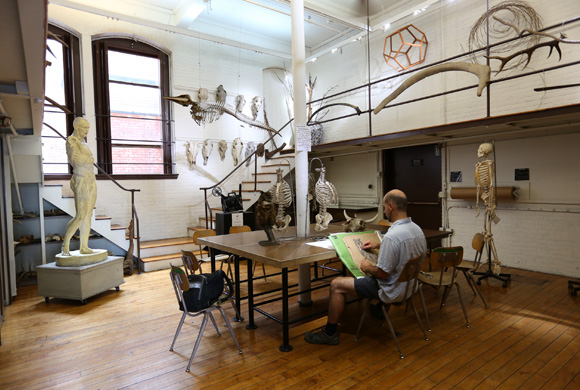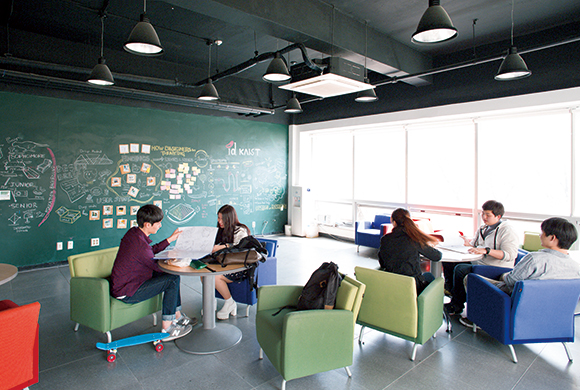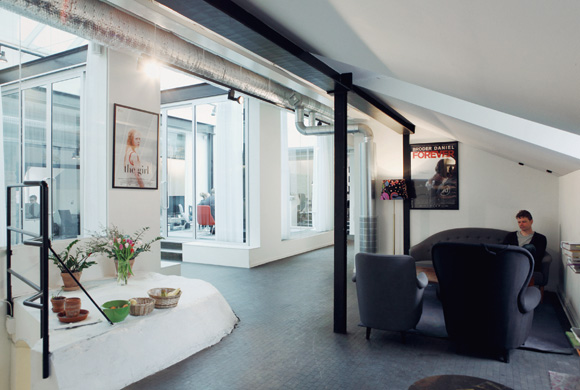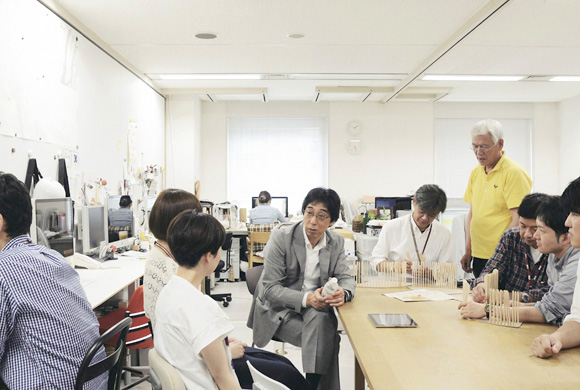Workplace
Aug. 26, 2013
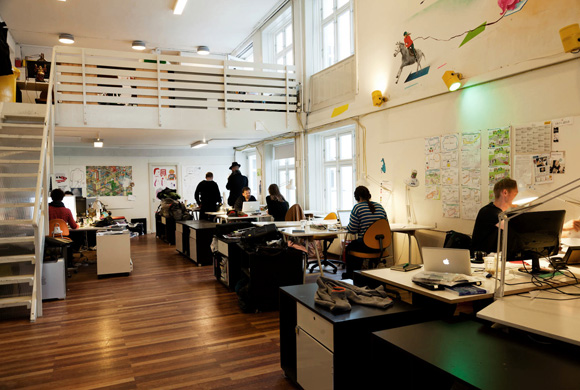
A Friendly and Cozy Atmosphere Connects Various Talents
A co-working space for creative people to meet and communicate
[Republikken] Copenhagen, Denmark
Republikken was launched in 2005, providing co-working space to people working in creative fields. At first, the majority was media people, such as graphic designers, web designers and photographers, and later came an increasing number of people in engineering and design fields, such as architects, design engineers and industrial designers.
Today, Repubulikken has about 90 clients who work here. Most of them are in creative jobs. The relationship goes beyond industry or affiliation, as people network frequently, bringing together their talents and ideas and join in a range of collaborations in a newly-created location in Copenhagen.
The heart of the facility is a spacious open office that can accommodate 70 to 80 people. The clients are guaranteed a workplace here. Contracts are for a minimum of three months, which can then be renewed on a monthly basis. In fact, many of the members have signed long-term contracts, once they discover that they like the environment and culture.
Apart from the open office, the facilities include an event space and large conference room, a spacious cafeteria, a workshop, a design room, and a meeting room. As soon as the contract has been exchanged, the members can use all the facilities. In the workshop, CNC machinery and other equipment are installed. Sometimes such equipment is difficult for freelancers to have and this can be of a great help to the members’ works.
The owners who co-manage Republikken try to provide a work environment that has consistent quality, while making every effort at creating connections between people. “We place particular importance on the communication between our clients,” says Lau Gotthard Christensen, one of the partners. “It’s very important for us to continue to expand our network.”
By sharing the workspace and facilities, people naturally become acquaintances. But that alone does not ensure the development of collaboration. Even if there are skills needed and a good network, everything comes to an end if relationships remain at a formal level.
To make communication happen naturally and smoothly, the Republikken management actively encourages meetings in the café, initiates conversations and always remembers the need to build an open atmosphere. They emphasizes that it’s always good to meet with everyone, and they regularly host lunch for the members and ask each person to explain about their work in 45 seconds.
The walls on each floor are display space with client profiles or staff recruitment notices, and more than a few collaborations have actually come about because of this.
 Founded: 2005
Founded: 2005
Clients: 75 individuals, five companies
Republikken is a working space for creative people and entrepreneurs in the heart of Copenhagen. Members represent a wide range of fields, including designers, graphic designers, media representatives, crafts people and artists.
http://republikken.net/
 A space for media people is located on the second floor. Some seats are on a reservation basis, with contracts on a three-month basis, renewable every month.
A space for media people is located on the second floor. Some seats are on a reservation basis, with contracts on a three-month basis, renewable every month.
 The second floor cafeteria/meeting area. A bowl of nuts has been set out for everyone to enjoy.
The second floor cafeteria/meeting area. A bowl of nuts has been set out for everyone to enjoy.
 Lau Gotthard Christensen
Lau Gotthard Christensen
Partner
A family atmosphere is also important at Republikken. For example, when the “captain”—the staff in charge of the open office—reached his fifth year working at Republikken, everybody was naturally in a celebratory mood and started planning a party. This idea was brought up by the members. The owners were touched by this and also this incident made them realize that people are feeling very much at home in this place and friendship and care for each other are growing naturally.
One of Republikken’s characteristics is that the users can personally design their own workspace. When there is a refurbishment to be done, everyone contributes ideas, while all the engineering and architectural designers work on the tables, chairs, shelves and the whole interior. The graphic designers paint artworks on the walls. This kind of office creation takes more time and effort than using off-the-shelf materials, but it’s become the Republikken style. Moving ahead step-by-step like this means that the clients understand that this is not just a rented space, but is one’s own personal space.
One of the owners’ concepts is that if they connect people, business opportunities will emerge—but they don’t want to overly interfere with members’ activities. Basically, they leave things to the members’ own devices and spontaneity. This sense of balance has been fostered through the trial and error that has carried on since the beginning of Republikken.
For example, they tried moving people to new desks regardless of their industry or job, encouraging people to connect with those who have different specialties, but this attempt did not quite work out. “Mostly graphic designers and web designers want to work together, as architects and industrial designers do,” Mr. Christensen says.
Today, the two main client groups— media and architecture — are working on two separate floors. There is a kitchen area between the two floors, separated by a wall, but this doesn’t mean that exchange is blocked off. Coming into the kitchen to make coffee or participate in the 12 o’clock lunch can also be a good opportunity to meet clients from the two different floors, to have a chat and have good communications.
 Posters and other materials contributed by participating members. Through various works, members can extend and enhance their abilities and experiences.
Posters and other materials contributed by participating members. Through various works, members can extend and enhance their abilities and experiences.
 A large space for events and other activities. The color of the lights can be changed to red, blue, yellow and green.
A large space for events and other activities. The color of the lights can be changed to red, blue, yellow and green.
 Meeting space for four to six people. It is used when a closed area is needed.
Meeting space for four to six people. It is used when a closed area is needed.

There are three spaces called “wings” in Republikken; this is one of them. All together Republikkens is very spacious at more than 2,000㎡.
 360°View
360°ViewThere are three spaces called “wings” in Republikken; this is one of them. All together Republikkens is very spacious at more than 2,000㎡.
*Touch Picture for 360° View
Republikken also hosts events for public as well as for the members. As they have vast resources of the talented members, they host events such as graphic design classes, lampshade-building contests, and other activities to connect members as well as to broaden network with public.
For Christmas 2012, Republikken joined in a collaboration with FabCafe in Shibuya*, a café and space for monozukuri, literally, “creating things.” People from Republikken and FabCafe digitally created tree ornaments; exchanged the data by emails, used laser cutters to cut out and make actual ornaments—a unique form of exchanging presents between the two groups.
These kinds of group work and events increase the feeling of the sense of community.
“It’s important that this be a place that generates revenue for Republikken for its continual development, but it’s not just about profit,” says Mr. Christensen. “It’s important that the culture is one that helps build the career of those working here.” The members also feel the pleasure of contributing to this. This increases the value of Republikken as a co-working space, one that helps to attract new creative people as well.
Web-exclusive contents
January 28, 2013 interview in Copenhagen, Denmark
 Equipment for publishing, including a high quality printer. This allows users access to otherwise very expensive equipment.
Equipment for publishing, including a high quality printer. This allows users access to otherwise very expensive equipment.
*FabCafe in Shibuya
http://tokyo.fabcafe.com/en/
A café Located in Shibuya in Tokyo founded for a place where creative people can meet to make new things. People can use various digital tools such as a 3D printer, a laser cutter to work. Republikken has had a collavorative event with Fabcafe in Shibuya to make and exchange Christmas ornaments.
 One of the kitchens. This is where networking takes place. People share lunch and discuss various issues.
One of the kitchens. This is where networking takes place. People share lunch and discuss various issues.






